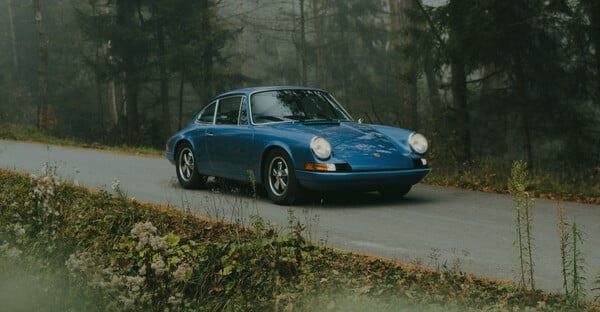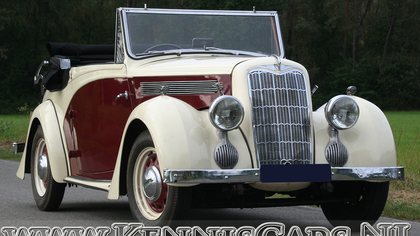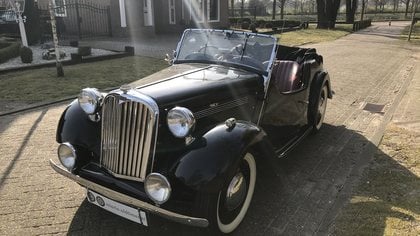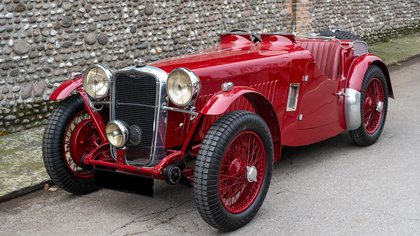Description
Singer Roadster 4AB. 1951 Registered
Registration Number JER 500
I first came across this car in 1997 when visiting a well-known Singer Roadster restoration specialist, Trevor Cornelius, based in Kent. Trevor had acquired it from the previous owner in Preston, Yorkshire. It had had several previous owners in that area, but it was originally registered in 1951 in Peterborough, Northamptonshire. Trevor was, at the time, the Registrar for the Singers Owners Club and had access to original Roadster parts held by the club, as well as club certified suppliers of replacement components. I was visiting him in search of exactly this model, having owned and sold my first one as a student back in the 1960’s. The car I was now viewing clearly needed some extensive renovation work. However I was aware that with Trevor’s many years of experience on this particular model and his access to genuine replacement components, this was the ideal way to acquire a Roadster 4AB which I could rely on for the long term. Now, 28 years later I can look back and say I was absolutely right.
My brief to Trevor was for the car to remain strictly to the original 1951 mechanical and electrical specifications and he was in the position to adhere rigidly to this. The engine was replaced at that time with a reconditioned one of 1074cc, the same as was fitted when new. An original detailed list of the work he did to the car at that time is available. Since it’s restoration the car has always been stored indoors and has had regular use. It has been regularly serviced over the years and the engine has been converted to run on modern lead-free petrol. A service has just been completed. During the most recent service a new battery was installed and a new set of tyres fitted.
Although it is an “Historic Vehicle “and does not legally require an MOT, it has recently been tested and passed, and now has a current MOT test certificate. There were a couple of advisory comments on the test listed as:- Slight free play detected in steering box. Slightly worn swivel pins/ bushes. Whilst these issues were not rated in the test as needing action, they should be monitored during future servicing and, if necessary, repair undertaken.
The car is now 73 years old and as such will need regular annual servicing and occasional repair to maintain its current very useable condition. Over the years, I have ensured that the service and any subsequent repairs have been carried out by mechanics experienced in vintage car work. I recommend any Roadster 4AB owner joining The Singers Owners Club as members advice and access to genuine spares can be invaluable to new owners.
The registration number, JER 500, has been the subject of interest and offers as a “cherished number plate” over the years and has been recently valued separately to the car at £4, 500 . For the moment, it remains with this car and is included in the car sales price.
Model:- Singer Roadster 4AB
Taxation Class:- Historic Vehicle ( No UK tax payable)
Cylinder Capacity:- 1074 cc
Fuel:- Unleaded petrol
Chassis/ Frame Number:- 4AB7074U
Engine Number:- 4AB33422
Manufactured:- 1951Vehicle history.
I have been a long-time enthusiast of the Singer Roadster 4AB. I owned my first one as a student in 1963. The car I am selling here is a similar Roadster 4AB model which I have owned and driven since 1997. This car was first registered on 26th January 1951 in Peterborough, but by the time I came across it, had been owned by several individuals in Yorkshire. It was restored and renovated for us at that time by Trevor Cornelius, as outlined in the vehicle description above. When first viewed it was in its original colour of red, the same as my first Roadster 4AB. Both my wife and I thought a change would be welcome and, as she is a talented artist with an eye for these things, I stepped back and gave her free rein on the colour scheme. I hope you will agree from the attached pictures that her choice of a soft white for the body work and pale browns for the hood, tonneau cover and upholstery, worked beautifully. The car came to us resplendent in new paintwork, hood, tonneau cover, trim and reconditioned arm indicators and it still looks great today.
I have always admired the sporty, flowing lines of the Roadster 4AB, but I think what has impressed me most about the model over the years, is its adaptability and functionality. It turns heads and stops passers-by when in its racier look, but also works perfectly as a 4-seater family car. As will be seen in the attached photographs, it is a stunning looker in its “racing” mode with the hood down and side screens off, the windscreen lowered down onto the bonnet and the wind deflected from driver and passenger by the sculptured shape of the fascia. Perfect for a drive on a balmy, summer’s day. A complete contrast to the cosy car with the windscreen back up, the sides screens in place and the hood raised; more suitable for a dull rainy winter’s day. And, in between those two extremes, as the photographs show, all sorts of combinations are possible with, the windscreen, the hood, the side screens and the tonneau cover all available for use and all dependant on your mood or the demands of the weather!
The Singer Roadster 4ABs have given my wife and I much fun and pleasure over the years, from student days to late in retirement. But now that I'm well into my "80's", she has finally convinced me it is time to let someone else have the pleasure of owning and driving it.
THE SINGER ROADSTER HISTORY.
The Roadster range was manufactured, by Singer Motors Limited of Coventry, as a nine horsepower (1074 cc), 2/ 4-seater sports-tourer from 1939 to 1955. It was launched in March 1939 as an open version of Singer's Bantam saloon, using many Bantam parts including a three speed, manual gear box. After less than six months, production was suspended for the duration of World War II. The successful Roadster re-appeared in 1946 and was upgraded to the 4A model in 1949 with a four speed, manual gearbox. The car for sale here is an example of a further update, the 4AB, released in 1950. While superficially similar to earlier models, this has an independent front suspension using coil springs and a hybrid, "hydro-mechanical" brake system by Girling. The flowing lines of the Singer Roadster made it one of the most attractive roadsters in the market. Advertising copy for the model incorporated "from the inspiration of the Singer Le Mans model". During the 1930’s, these took part in the Le Mans 24-hour Race as well as hill climbs, trials, and various international endurance races. Unlike the Le Mans, the Roadster was designed so it could be built in volume for normal road use. Although approximately 12, 700 Singer Roadsters were built, it is a car not commonly seen in the UK as nearly all post war production was exported, particularly to the USA. It was popular with the elite in India and featured in the collections of some Maharajas there.



















